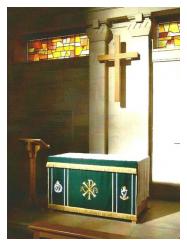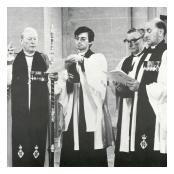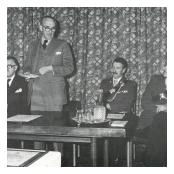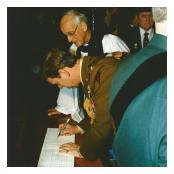The Regimental Chapel, St Anne's Cathedral, Belfast

|
| The Altar in the Regimental Chapel |
The Royal Irish Regiment's Regimental Chapel is situated in the north transept of Belfast Cathedral and was dedicated on 6 June 1981.
Construction of the cathedral began in 1899 and in 1976 a fund was launched to complete the original design and include a north transept. The Colonel of The Regiment requested his Advisory Council to study with the cathedral authorities how best the Regiment could help and, at the same time, provide a spiritual home for the Regiment.
Field Marshal Sir Gerald Templer launched the appeal shortly before his death in 1978. HRH Princess Alice, Duchess of Gloucester, whose late husband had been the first Colonel in Chief of the Royal Irish Rangers, took a keen interest in the appeal, as did Lady Templer after the death of Field Marshal Templer.
The Regimental Chapel was dedicated by the Rt Rev Arthur Butler, Bishop of Connor and a former Army Chaplain, at a special service on 6 June 1981, which was attended by many former and serving members of the Regiment and its antecedent regiments. Most of the furnishings in the Chapel have been gifted by former members of the Regiment, many in memory of fallen comrades. The chapel is dominated by a fine stained glass window bearing the regimental crests and includes lines from Binyon's “For the Fallen”. On the formation of the Royal Irish Regiment in 1992, the Chapel became the Regimental Chapel of the Royal Irish Regiment. Each year the Dean and Chapter of the Cathedral have granted the Regiment permission to hold two special services in the Cathedral. On the Sunday before the national Remembrance Sunday, the Regiment holds an Annual Remembrance Service and on the anniversary of the chapel’s dedication, a service of Holy Communion is held in the Chapel.
Unique amongst the items in the Regimental Chapel are:
a. The personal standard of Field Marshal Sir Gerald Templer as a Knight Grand Cross of the Order of St Michael and St George. The Field Marshall was president of the Royal Irish Rangers Chapel Appeal which he launched at St Patrick’s Barracks, Ballymena on 4th November 1979. Lady Templer kindly consented to become President in her late husband's place in 1980. The Field Marshall had been Chief of the Imperial General Staff from 1956 to 1958 and was Colonel of the Royal Irish Fusiliers from 1946 to 1960. His personal banner of Knight Grand Cross of the Most Distinguished Order of St Michael and St George hangs in the Chapel. The Order is associated with the Diplomatic Service and is not normally one to which soldiers are admitted. He was Director of Civil Affairs of 21st Army Group in Germany immediately after World War Two and Director of Operations in Malaya from 1952 to 1954.
b. The personal standard of General Sir James Steele as a Military Knight Grand Cross of the Order of the Bath. It previously hung over his stall in the King Henry VIII Chapel in Westminster Abbey. He joined the Royal Irish Rifles in 1914 from Queen’s University, Belfast and retired in 1950 as Adjutant General. As Director of Staff Duties he organised the mobilisation of the army for World War Two and it's demobilisation at the end of the war. He was also instrumental in setting up the Army Benevolent Fund, now ABF The Soldiers’ Charity.
c. A unique book of prayers presented to Captain (later Major General) James Majury when imprisoned as a POW during the Korean War. The then Captain James Majury was captured by the Chinese whilst serving with the Royal Ulster Rifles in Korea in 1951. During his incarceration in North Korea he took over running church services in his camp when the Chinese removed the chaplain. As a token of gratitude two of his fellow prisoners presented him with a prayer book written on rice paper. The prayers in the book are those used by James Majury, many adapted from the Book of Common Prayer. General Majury's widow kindly presented the book to the Regiment after his death in 1996. The prayer book underwent significant conservation work in 2019, funded by the Regiment.
d. The last Stand of Colours carried by the 1st Battalion The Royal Inniskilling Fusiliers have been box-framed and installed in the Chapel. They were presented by the then Colonel in Chief, His Royal Highness the Duke of Gloucester, Earl of Ulster in Nairobi, Kenya in 1962.
e. The last Stand of Colours carried by the 1st Battalion The Royal Irish Fusiliers have been box-framed and installed in the Chapel. They were presented by Field Marshall Sir Gerald Templer in Celle, West Germany in 1965.
f. The following Colours are laid up in the Chapel:
- 1st and 2nd Battalions The Royal Irish Rangers. The only Stand of Colours carried by the 1st Battalion have been box-framed and installed in the Chapel. The Colours presented to the 2nd Battalion hang over the entrance to the Sanctuary. Both stands were presented by Her Royal Highness the Duchess of Gloucester in Warminster in 1972.
- The North Irish Militia. The only Stand of Colours carried by the North Irish Militia, later the 4th Battalion, Royal Irish Rangers have been box-framed and installed in the Chapel. They were presented by Her Royal Highness the Duchess of Gloucester in Warminster in 1972.
- 7th/10th Battalion The Ulster Defence Regiment. The only Stand of Colours carried by the 7th/10th Battalion have been box-framed and installed in the Chapel. They were presented by Her Majesty The Queen in Lisburn, Northern Ireland in 1991.
- 2nd Battalion The Royal Irish Regiment. The only Colours carried by the 2nd (Home Service) Battalion Royal Irish Regiment are boxed and installed in the Chapel. The Regimental Colour carries the emblem of the Conspicuous Gallantry Cross awarded to the Regiment by Her Majesty in 2006.
g. Books and Scrolls of Remembrance:
- The Royal Ulster Rifles, containing the names of almost 9,000 Riflemen of The Royal Irish Rifles and the Royal Ulster Rifles who gave their lives between 1881 and 1968.
- The Royal Irish Rangers, listing the names of Rangers who gave their lives between 1968 and 1992.
- The Ulster Defence Regiment, containing the names of those who gave their lives between 1970 and 1992.
- The Royal Irish Regiment, containing the names of those who have died in Service since the formation of the Regiment in 1992.
(The relatives of those commemorated may examine the Books of Remembrance by applying to Regimental Headquarters or the Cathedral Office in advance of a visit)
h. Two panels, one showing holders of the Victoria Cross, the other the battalions of The Ulster Defence Regiment.
i. In front of the Chapel on the ambulatory pillars hang the standards of those old comrades’ associations of the World War One Service Battalions of the Royal Irish Rifles. These Battalions were formed from the old UVF battalions raised by Sir Edward Carson during the Home Rule crisis in Ireland in 1912. At the time, the UVF had 80,000 enrolled men. The battalions became part of 36th (Ulster) Division which suffered over 7,000 dead on the first day of the Battle of the Somme on 1st July 1916.
j. The Palestine Font. This Font originally stood in the Garrison Church in Sarafand in Palestine. It was a memorial to one Officer and 5 Riflemen killed on operations with 2nd Battalion Royal Ulster Rifles 1935 – 1937. It was recovered by Captain W R H Charley on the British withdrawal from Palestine in 1947.
k. The Normandy Lectern. This Lectern was presented by the Royal Ulster Rifles Association to commemorate those officers and soldiers from the 1st and 2nd Battalions who gave their lives in 1944. The Royal Ulster Rifles was unique in having a battalion (1st) serving as glider borne troops with 6th Airborne Division and another (2nd) which, as part of 3rd Infantry Division, landed by sea on D-Day.
l. Chapel Chairs. The chairs in the chapel have memorial plates dedicated to individual Officers and soldiers of the Regiment and its antecedents. The kneelers were presented by the Cathedral Embroiderers Guild.
In addition to those items displayed in the Regimental Chapel the following items are kept in the cathedral treasury, located on the opposite side of the cathedral:
A silver gilt chalice and paten in memory of Colonel R G Maddocks, the first Chairman of the Regimental Chapel Committee, which was presented by his family.
A pair of silver candlesticks presented by the Regiment to the cathedral to mark the 30th anniversary of the dedication of the Regimental Chapel.
Panoramic (Drag image left, right, up and down to view.)
View a 360° panoramic of The Regimental Chapel in St Anne's Cathedral, Belfast








